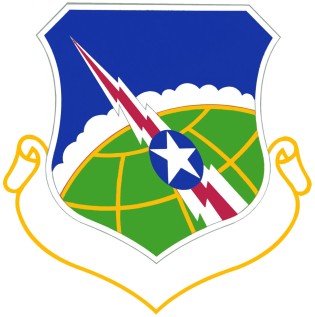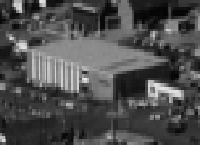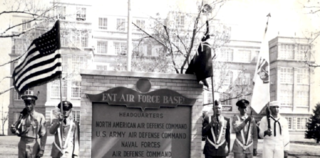
North American Aerospace Defense Command, known until March 1981 as the North American Air Defense Command, is a combined organization of the United States and Canada that provides aerospace warning, air sovereignty, and protection for Canada and the continental United States.

The Cheyenne Mountain Complex is a Space Force installation and defensive bunker located in unincorporated El Paso County, Colorado, next to the city of Colorado Springs, at the Cheyenne Mountain Space Force Station, which hosts the activities of several tenant units. Also located in Colorado Springs is Peterson Space Force Base, where the North American Aerospace Defense Command (NORAD) and United States Northern Command (USNORTHCOM) headquarters are located.
Ent Air Force Base was a United States Air Force base located in the Knob Hill neighborhood of Colorado Springs, Colorado. A tent city, established in 1943 during construction of the base, was initially commanded by Major General Uzal Girard Ent (1900–1948), for whom the base is named. The base was opened in 1951.

The RCA 474L Ballistic Missile Early Warning System was a United States Air Force Cold War early warning radar, computer, and communications system, for ballistic missile detection. The network of twelve radars, which was constructed beginning in 1958 and became operational in 1961, was built to detect a "mass ballistic missile attack launched on northern approaches [for] 15 to 25 minutes' warning time" also provided Project Space Track satellite data.

Peterson Space Force Base, previously Peterson Air Force Base, Peterson Field, and Army Air Base, Colorado Springs, is a U.S. Space Force Base that shares an airfield with the adjacent Colorado Springs Municipal Airport and is home to the North American Aerospace Defense Command (NORAD), the Space Force's 21st Space Wing, elements of the Space Force's Space Systems Command, and United States Northern Command (USNORTHCOM) headquarters. Developed as a World War II air support base for Camp Carson, the facility conducted Army Air Forces training and supported Cold War air defense centers at the nearby Ent Air Force Base, Chidlaw Building, and Cheyenne Mountain Complex. The base was the location of the Air Force Space Command headquarters from 1987 to 20 December 2019 and has had NORAD/NORTHCOM command center operations since the 2006 Cheyenne Mountain Realignment placed the nearby Cheyenne Mountain Complex on standby. On 26 July 2021, the installation was renamed Peterson Space Force Base to reflect its prominent role in the new space service.

Aerospace Defense Command was a major command of the United States Air Force, responsible for continental air defense. It was activated in 1968 and disbanded in 1980. Its predecessor, Air Defense Command, was established in 1946, briefly inactivated in 1950, reactivated in 1951, and then redesignated Aerospace rather than Air in 1968. Its mission was to provide air defense of the Continental United States (CONUS). It directly controlled all active measures, and was tasked to coordinate all passive means of air defense.

The 23rd Air Division is an inactive United States Air Force intermediate echelon command and control organization. It was last assigned to First Air Force, Tactical Air Command (ADTAC). It was inactivated on 1 July 1987 at Tyndall Air Force Base, Florida.

The 9th Space Division is an inactive United States Air Force organization. Its last assignment was with Air Force Space Command, being stationed at Patrick Air Force Base, Florida. It was inactivated on 1 October 1991.

The 24th Air Division is an inactive United States Air Force intermediate echelon command and control organization. It was last assigned to First Air Force, Tactical Air Command (ADTAC). It was inactivated on 30 September 1990 at Griffiss Air Force Base, New York.

The 25th Air Division is an inactive United States Air Force intermediate echelon command and control organization. It was last assigned to First Air Force, Tactical Air Command (ADTAC). It was inactivated on 30 September 1990 at McChord Air Force Base, Washington.

The 26th Air Division is an inactive United States Air Force organization. Its last assignment was with Air Defense Tactical Air Command, assigned to First Air Force, being stationed at March Air Force Base, California. It was inactivated on 30 September 1990.

The 29th Air Division is an inactive United States Air Force organization. Its last assignment was with Air Defense Command, being stationed at Duluth International Airport, Minnesota. It was inactivated on 15 November 1969.

The 32d Air Division is an inactive United States Air Force organization. It was last active with Air Defense Command, assigned to First Air Force at Gunter Air Force Base, Alabama, where it was inactivated on 31 December 1969.
The Aerospace Defense Center (ADC) was a unit of the United States Air Force. It was under the command of the general that also commanded both North American Aerospace Defense Command and Aerospace Defense Command (ADCOM). The center included the Office of Astrodynamics (ADC/DO6) and the Office of History.

Cheyenne Mountain Space Force Station (CMSFS) is located in Cheyenne Mountain on the Front Range of the Rocky Mountains in unincorporated El Paso County, Colorado, next to Colorado Springs, The Cheyenne Mountain Complex, an underground facility within Cheyenne Mountain SFS, was first built for the North American Aerospace Defense Command (NORAD) Combat Operations Center, though NORAD moved day-to-day operations to its headquarters on Peterson AFB in 2006. However, day-to-day operations were moved back in 2011 after a major overhaul and renovation. The location now supports U.S. Space Command's Missile Warning Center, other strategic warning and survivable capabilities, and provides a ready alternative operating location for NORAD's command center.

The Space Defense Center (SDC) was a space operation center of the North American Aerospace Defense Command. It was successively housed at two Colorado locations, Ent Air Force Base, followed by Cheyenne Mountain's Group III Space Defense Center The 1st Aerospace Control Squadron manned the SDC at both locations, which used the Electronic Systems Division's 496L System for processing and displaying data combined from the U.S. "Air Force's Space Track and the Navy's Spasur" (NAVSPASUR).

The Federal Building, originally the Burroughs Building, was a Cold War military computer systems building on the Ent Air Force Base in Colorado Springs. It was built in 1962 to be used by Burroughs Corporation for its project to build an automated facility to take input, like satellite and radar information, and instantaneously assess its degree of combat importance. The program was designed in conjunction with Air Force 425L System Project engineers and was an important component in North American Aerospace Defense Command (NORAD)'s command and control system. It was an Ent Air Force Base building until 1975 when the base was inactivated. It then became an off-base installation to the Peterson Air Force Base. Over the next several decades there were varying uses for the building by the federal government. After 2007, the building was vacated and in 2009 it was sold.

Continental Air Defense Command (CONAD) was a Unified Combatant Command of the United States Department of Defense, tasked with air defense for the Continental United States. It comprised Army, Air Force, and Navy components. It included Army Project Nike missiles anti-aircraft defenses and USAF interceptors. The primary purpose of continental air defense during the CONAD period was to provide sufficient attack warning of a Soviet bomber air raid to ensure Strategic Air Command could launch a counterattack without being destroyed. CONAD controlled nuclear air defense weapons such as the 10 kiloton W-40 nuclear warhead on the CIM-10B BOMARC. The command was disestablished in 1975, and Aerospace Defense Command became the major U.S. component of North American Air Defense Command (NORAD).

The Missile Warning Center (MWC) is a center that provides missile warning and defense for United States Space Command's Combined Force Space Component Command, incorporating both space-based and terrestrial sensors. The MWC is located at Cheyenne Mountain Space Force Station.

Construction of the Cheyenne Mountain Complex began with the excavation of Cheyenne Mountain in Colorado Springs, Colorado on May 18, 1961. It was made fully operational on February 6, 1967. It is a military installation and hardened nuclear bunker from which the North American Aerospace Defense Command was headquartered at the Cheyenne Mountain Complex. The United States Air Force has had a presence at the complex since the beginning, the facility is now the Cheyenne Mountain Space Force Station, which hosts other military units, including NORAD.



















